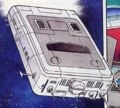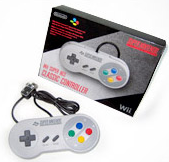Super Nintendo Entertainment System: Difference between revisions
m (→SNES Mouse) |
|||
| Line 38: | Line 38: | ||
|Europe never released a redesign model? | |Europe never released a redesign model? | ||
|} | |} | ||
==Cartridge Forms== | |||
Only in North America is the design different from other regions. It is possible to play games from other regions as internally the hardware is region free, but one would have to cut out tabs or get an adapter that would otherwise prevent the cartridges from making contact with the cartridge slot. The pin configurations are the same and compatible, unlike the [[Family Computer]] and [[Nintendo Entertainment System]] cartridges. | |||
Many early SNES cartridges had a long crevice spanning the cartridge. This was to prevent people from pulling the cartridges out when the system was turned on. Later SNES cartridges opted into a different design because people were possibly breaking their SNES units.{{refneeded}} The older cartridges will work on the redesigned SNES with no issues. It even lacks the tab to prevent people from pulling the cartridges out. Only North America seems to have this redesign. | |||
<gallery> | |||
SMW Cartridge 1.jpg | |||
SMW Cartridge 2.jpg | |||
SMW Cartridge 3.jpg | |||
SMW Cartridge 4.jpg | |||
SMW Cartridge 5.jpg | |||
SMW Cartridge 6.jpg | |||
SMW Cartridge 7.jpg | |||
==Accessories== | ==Accessories== | ||
Revision as of 19:23, March 27, 2017
It has been requested that this article be rewritten. Reason: general reorganization
Template:System-Infobox Template:LLQuote
The Super Nintendo Entertainment System (abbreviated to SNES, Super NES or Super Nintendo, Japanese: Super Famicom; also called in early development NES2 or Nintendo Entertainment System 2) is a video game console created by Nintendo. It was the successor to the original Nintendo Entertainment System and rivaled in performance to the Sega Mega Drive/Genesis. It had many popular games, including Super Mario World, Super Mario Kart, Super Mario All-Stars and Super Mario World 2: Yoshi's Island. Other popular titles are Super Mario RPG: Legend of the Seven Stars and Mario Paint.
The Super Famicom was released in Japan on November 21, 1990 while the Super Nintendo Entertainment System was released in America on August 13, 1991, in Europe in April 1992 and in Australia in July 1992. They were discontinued in 1999, followed by the Famicom model and the SNES/Super Famicom games which discontinued in 2000. It remained popular throughout the 32/64 bit era, selling 49.10 million units during its lifetime. Nintendo also worked with Sony to create the planned add-on, the SNES CD to rival against Sega CD. However, Nintendo's cooperation with Sony crumbled so the SNES CD was moved to Philips for a short time. The projects resulted in the Philips CD-i and the Sony PlayStation.
The SNES was re-released as the SNES 2, being released at the same time as the Nintendo 64. As well as this, it was smaller and lacked the eject button. It also could not output the S-Video and RGB signals.
During the SNES era, Nintendo and Sega were at the peak of their rivalry, so in many of the Mario games there were elements that mocked the Sonic the Hedgehog series and vice versa. In Donkey Kong Country 2: Diddy's Kong Quest, Sonic's boots and the plasma gun from Earthworm Jim are seen next to a bin and labeled "no hopers". In Super Mario World 2: Yoshi's Island, there are blue hedgehog enemies that greatly resemble Sonic the Hedgehog.
Redesigns
The SNES was based on a Japanese console called the Super Famicom. Famicom was a portmanteau of Family and Computer. There are obvious performance and aesthetic differences between the two consoles. It was re-released as a Super Famicom Jr., matching a USA SNES 2, but obviously, with the same differences as the SNES 1 and Super Famicom had.
The PAL SNES is a mix between the Super Famicom and the USA SNES, keeping the design of the Super Famicom, but using the name from the USA version.
| Japan | North America | Europe/Australia | |
|---|---|---|---|
| First model | 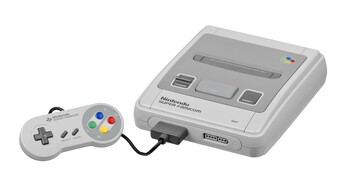 Super Famicom |
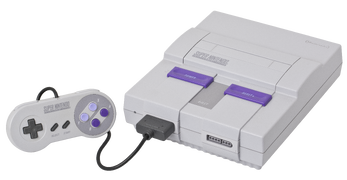 Super Nintendo Entertainment System |
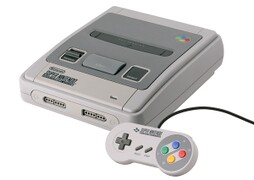 Super Nintendo Entertainment System |
| Second model | 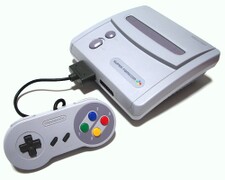 Super Famicom Jr. |
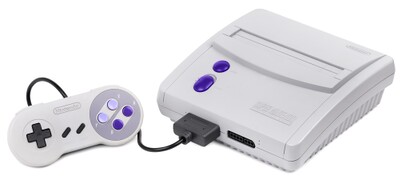 Template:Conjecturaltext |
Europe never released a redesign model? |
Cartridge Forms
Only in North America is the design different from other regions. It is possible to play games from other regions as internally the hardware is region free, but one would have to cut out tabs or get an adapter that would otherwise prevent the cartridges from making contact with the cartridge slot. The pin configurations are the same and compatible, unlike the Family Computer and Nintendo Entertainment System cartridges.
Many early SNES cartridges had a long crevice spanning the cartridge. This was to prevent people from pulling the cartridges out when the system was turned on. Later SNES cartridges opted into a different design because people were possibly breaking their SNES units.Template:Refneeded The older cartridges will work on the redesigned SNES with no issues. It even lacks the tab to prevent people from pulling the cartridges out. Only North America seems to have this redesign.
- ==Accessories==
- ===SNES Controller===
- There is also a Wii adaption of the SNES controller for use as a substitution for the Classic Controller with games that support said controller.
- ===Super Game Boy===
- ===SNES Mouse===
- The SNES Mouse was originally bundled with ''Mario Paint'' and a mouse pad for $59.95.
- ====''Mario'' Games Compatible With the SNES Mouse====
- ===Super Scope===
- ===Super Multitap===
- ===Satellaview===
- ==Appearances in the ''Mario'' series==
- MonkeyMuseum.png
Donkey Kong Country 2: Diddy's Kong Quest
- TheFlyingKrock2.png
Donkey Kong Country 2: Diddy's Kong Quest
- WW CartidgeMicrogame.jpg
WarioWare: Smooth Moves
References in later console generations
For the Australian Club Nintendo, it had a reward option to request a Classic Controller themed after a European SNES controller.
Game gallery
- Original DKC3 box US.jpg
- ENTIRE warioMario box.JPG
- SMK BoxCover1.jpg
Trivia
- The North American SNES color scheme would later be used as an alternate costume for R.O.B. in Super Smash Bros. Brawl and Super Smash Bros. for Nintendo 3DS / Wii U.










